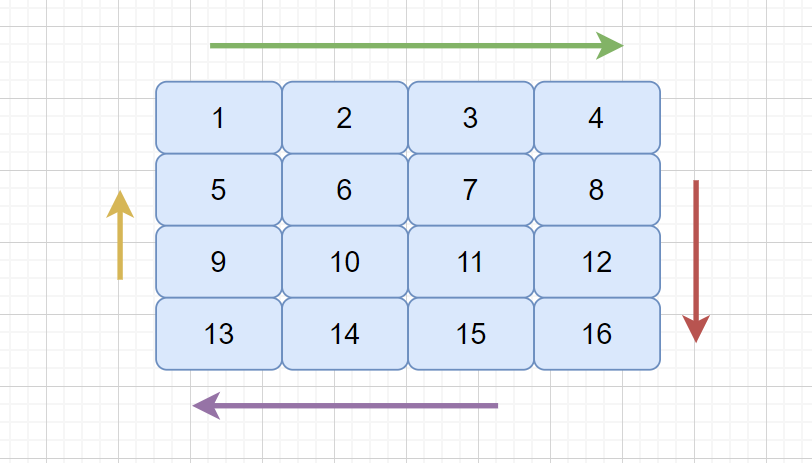mirror of
https://github.com/chefyuan/algorithm-base.git
synced 2024-11-01 09:43:38 +00:00
# Conflicts: # animation-simulation/数组篇/leetcode219数组中重复元素2.md # animation-simulation/数组篇/leetcode59螺旋矩阵2.md # animation-simulation/数组篇/leetcode66加一.md # animation-simulation/数组篇/leetcode75颜色分类.md
5.8 KiB
5.8 KiB
如果阅读时,发现错误,或者动画不可以显示的问题可以添加我微信好友 tan45du_one ,备注 github + 题目 + 问题 向我反馈
感谢支持,该仓库会一直维护,希望对各位有一丢丢帮助。
另外希望手机阅读的同学可以来我的 公众号:袁厨的算法小屋 两个平台同步,想要和题友一起刷题,互相监督的同学,可以在我的小屋点击刷题小队进入。
54. 螺旋矩阵
题目描述
给定一个包含 m x n个元素的矩阵(m 行, n 列),请按照顺时针螺旋顺序,返回矩阵中的所有元素。
示例一
输入:matrix = 1,2,3],[4,5,6],[7,8,9 输出:[1,2,3,6,9,8,7,4,5]
示例二
输入:matrix = 1,2,3,4],[5,6,7,8],[9,10,11,12 输出:[1,2,3,4,8,12,11,10,9,5,6,7]
这个题目很细非常细,思路很容易想到,但是要是完全实现也不是特别容易,我们一起分析下这个题目,我们可以这样理解,我们像剥洋葱似的一步步的剥掉外皮,直到遍历结束,见下图。
题目很容易理解,但是要想完全执行出来,也是不容易的,因为这里面的细节太多了,我们需要认真仔细的考虑边界。
我们也要考虑重复遍历的情况即什么时候跳出循环。刚才我们通过箭头知道了我们元素的遍历顺序,这个题目也就完成了一大半了,下面我们来讨论一下什么时候跳出循环,见下图。
注:这里需要注意的是,框框代表的是每个边界。
题目代码:
Java Code:
class Solution {
public List<Integer> spiralOrder(int[][] matrix) {
List<Integer> arr = new ArrayList<>();
int left = 0, right = matrix[0].length-1;
int top = 0, down = matrix.length-1;
while (true) {
for (int i = left; i <= right; ++i) {
arr.add(matrix[top][i]);
}
top++;
if (top > down) break;
for (int i = top; i <= down; ++i) {
arr.add(matrix[i][right]);
}
right--;
if (left > right) break;
for (int i = right; i >= left; --i) {
arr.add(matrix[down][i]);
}
down--;
if (top > down) break;
for (int i = down; i >= top; --i) {
arr.add(matrix[i][left]);
}
left++;
if (left > right) break;
}
return arr;
}
}
C++ Code:
class Solution {
public:
vector<int> spiralOrder(vector<vector<int>>& matrix) {
vector <int> arr;
int left = 0, right = matrix[0].size()-1;
int top = 0, down = matrix.size()-1;
while (true) {
for (int i = left; i <= right; ++i) {
arr.emplace_back(matrix[top][i]);
}
top++;
if (top > down) break;
for (int i = top; i <= down; ++i) {
arr.emplace_back(matrix[i][right]);
}
right--;
if (left > right) break;
for (int i = right; i >= left; --i) {
arr.emplace_back(matrix[down][i]);
}
down--;
if (top > down) break;
for (int i = down; i >= top; --i) {
arr.emplace_back(matrix[i][left]);
}
left++;
if (left > right) break;
}
return arr;
}
};
Python3 Code:
from typing import List
class Solution:
def spiralOrder(self, matrix: List[List[int]])->List[int]:
arr = []
left = 0
right = len(matrix[0]) - 1
top = 0
down = len(matrix) - 1
while True:
for i in range(left, right + 1):
arr.append(matrix[top][i])
top += 1
if top > down:
break
for i in range(top, down + 1):
arr.append(matrix[i][right])
right -= 1
if left > right:
break
for i in range(right, left - 1, -1):
arr.append(matrix[down][i])
down -= 1
if top > down:
break
for i in range(down, top - 1, -1):
arr.append(matrix[i][left])
left += 1
if left > right:
break
return arr
Swift Code
class Solution {
func spiralOrder(_ matrix: [[Int]]) -> [Int] {
var arr:[Int] = []
var left = 0, right = matrix[0].count - 1
var top = 0, down = matrix.count - 1
while (true) {
for i in left...right {
arr.append(matrix[top][i])
}
top += 1
if top > down { break }
for i in top...down {
arr.append(matrix[i][right])
}
right -= 1
if left > right { break}
for i in stride(from: right, through: left, by: -1) {
arr.append(matrix[down][i])
}
down -= 1
if top > down { break}
for i in stride(from: down, through: top, by: -1) {
arr.append(matrix[i][left])
}
left += 1
if left > right { break}
}
return arr
}
}

